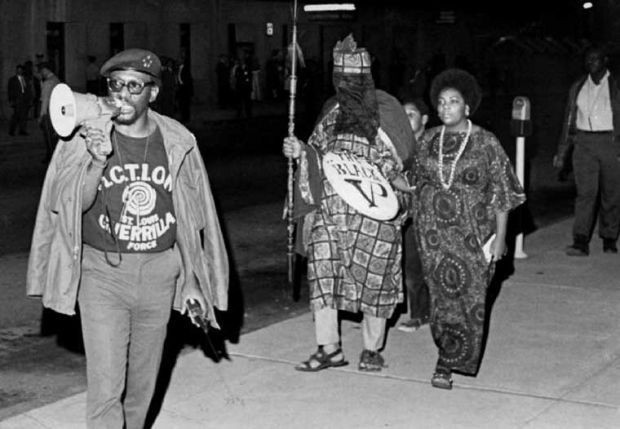True Reformer's Hall
Introduction
Text-to-speech Audio
Images
Description of the African Veiled Prophet Ball

The African Veiled Prophet took on a role of fighting for Civil Rights in the 1960s

Backstory and Context
Text-to-speech Audio
The story of the True Reformers Hall starts roughly thirty years before the purchasing of the building located at Pine and Jefferson. According to their own historical narrative, Twenty-Five Years History of the Grand Fountain of the United Order of True Reformers, 1881-1905, the Grand Fountain of the United Order of True Reformers emerged around 1873 in the eastern United States. The organization sprang forth in the wake of the chaos of the American Civil War. The True Reformers intended to be among the ranks of organizations intended to promote the well being of African Americans, especially those that had only recently been freed from slavery. In fact, several of the original members of the True Reformers, such as William Washington Brown, were former slaves. The True Reformers' history from the early twentieth century explains that they evolved from a separate organization known as the Independent Order of Good Templars, another group aimed at helping African Americans.
By the first decade of the twentieth century, the True Reformers had gained footholds throughout the United States, including in St. Louis. The organization needed places to serve as headquarters for different regions as well as provide meeting spots for African Americans in the Jim Crow Era. The True Reformers' history explains that around 1901, they purchased a piece of land at 2600 Pine Street in downtown St. Louis for $22,500. In 2020, according to the Bureau of Labor Statistics, that would be roughly the equivalent of $500,000. They renovated the building for another $1700, or about $44,000 in 2020. The establishment of this meeting place by the Grand Fountain of the United Order of True Reformers became a symbol of African American independence and agency in a time of systemic racial oppression.
The True Reformer's Hall's involvement in the Civil Rights Movement during the Jim Crow Era continues further into the twentieth century. This time, they focused on they had to face secret, white supremacist orders, such as the Mystic Order of the Veiled Prophet of the Enchanted Realm of Khorassan. This wealthy secret society, started in the 1870s, aimed at excluding all except the most prominent members of white society. Some saw the Mystic Order as a supposed high-society club for important Mason's. Each year, the organization hosted a formal gala, known as the "Veiled Prophet Ball," during which, a man known as the "Veiled Prophet," would enter the dance with his face covered, and he would select a woman to be his Queen of Love and Beauty. The organization in the early 1900s refused to admit people of color into the organization.
In response to the racially biased Mystic Order, a man named Abdul Menelik Ben Hassin created the African, or sometimes called Negro Veiled Prophet Society. In October 1905, Menelik Ben Hassin hosted the first African Veiled Prophet Ball at the True Reformer's Hall, where he too appointed a woman to be his queen. This society aimed to bring awareness to the intense racism and discrimination among the wealthiest members of St. Louis' population.
The African Veiled Prophet Society continued, even after the closure of the True Reformer's Hall in 1912. They hosted their ball at Jazzland in St. Louis, and in the 1960s, the African Veiled Prophet participated in public Civil Rights Movement demonstrations.
True Reformer's Hall, which sat at Pine and Jefferson until 1912, through its relationship to post-Civil War African American rights groups, and the Civil Rights Movement in the 1960s, holds a unique spot in St. Louis History
Sources
“Abdul Menelik Ben Hassin: The Celebrated African Prophet.” St. Louis Palladium. September 22, 1907. Accessed March 15, 2020. Newspapers.Com
"A Brilliant Affair," St. Louis Palladium, October 5, 1907, Accessed March 15, 2020. Newspapers.Com
Burrell, William Patrick, D.E. Johnson. Twenty-Five Years History of the Grand Fountain of the United Order of True Reformers, 1881-1905. Richmond: Grand Fountain of the United Order of True Reformers, 1909.
"CPI Calculator," Bureau of Labor Statistics, Accessed March 24, 2020, https://data.bls.gov/cgi-bin/cpicalc.pl
"Information Sheet: Mystic Order of Veiled Prophets of the Enhanted Realm of Khorassan, Alhambra Grotto Booklett, 1933." State Historical Society of Missouri. Accessed March 24, 2020. https://collections.shsmo.org/manuscripts/rolla/r1253.pdf
Naffgizer, Chris. "Centers of Community that were Destroyed in the Mill Creek Valley." St. Louis Magazine. September 26, 2019. Accessed March 24, 2020. https://www.stlmag.com/history/architecture/centers-of-community-that-were-destroyed-in-the-mill-creek-v/
“Ros Menelik. "Coloured Veiled Prophet at Jazzland.” St. Louis Argus,.October 10, 1919. Accessed March 15, 1919. https://archive.org/details/Oct10_201305/page/n3/mode/2up
St. Amand, Amanda. "50 Years Ago: Veiled Prophet Ball Becomes a Scene of Racial Protest." St. Louis Post Dispatch. October 3, 2019. Accessed March 24, 2020. https://www.stltoday.com/news/archives/years-ago-veiled-prophet-ball-becomes-a-scene-of-racial/article_0d45d7e8-1f78-5f31-9b3f-72eff42a3f3f.html
‘True Reformers Hall Will be Converted for Factory Use.” St. Louis Globe Democrat. May 15, 1912. Accessed March 15, 2020. Newspapers.com
Wright, John A. Discovering African American St. Louis: A Guide to Historic Sites. St. Louis: Missouri Historical Society Press, 2002.
“Abdul Menelik Ben Hassin: The Celebrated African Prophet.” St. Louis Palladium. September 22, 1907. Accessed March 26, 2020. Newspapers.Com
St. Amand, Amanda. "50 Years Ago: Veiled Prophet Ball Becomes a Scene of Racial Protest." St. Louis Post Dispatch. October 3, 2019. Accessed March 24, 2020. https://www.stltoday.com/news/archives/years-ago-veiled-prophet-ball-becomes-a-scene-of-racial/article_0d45d7e8-1f78-5f31-9b3f-72eff42a3f3f.html
